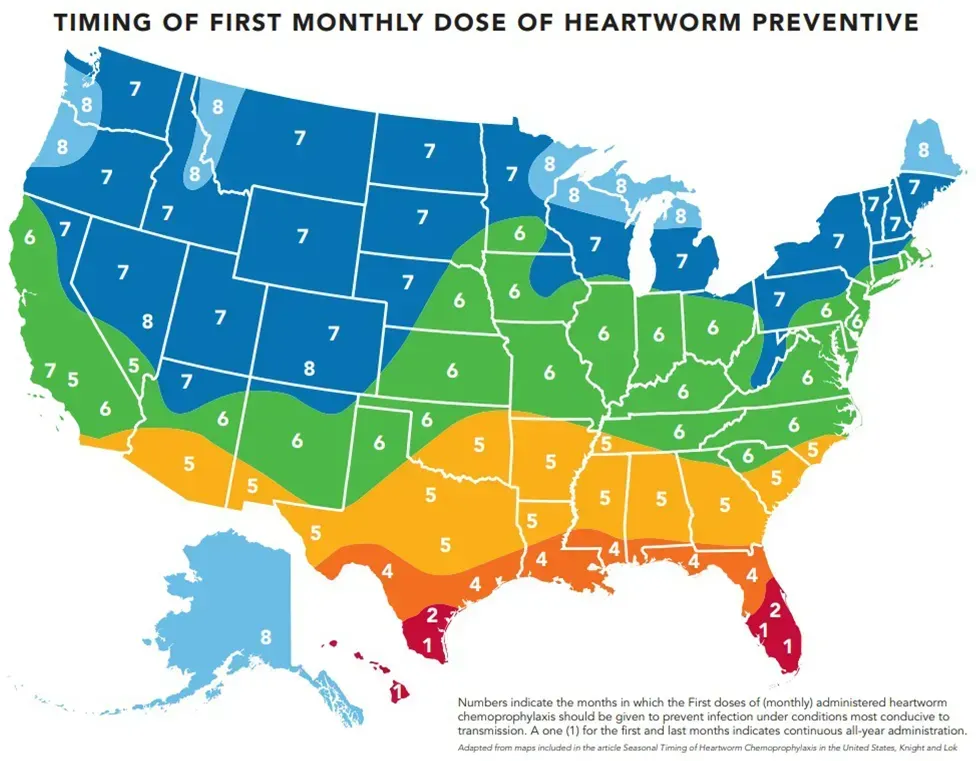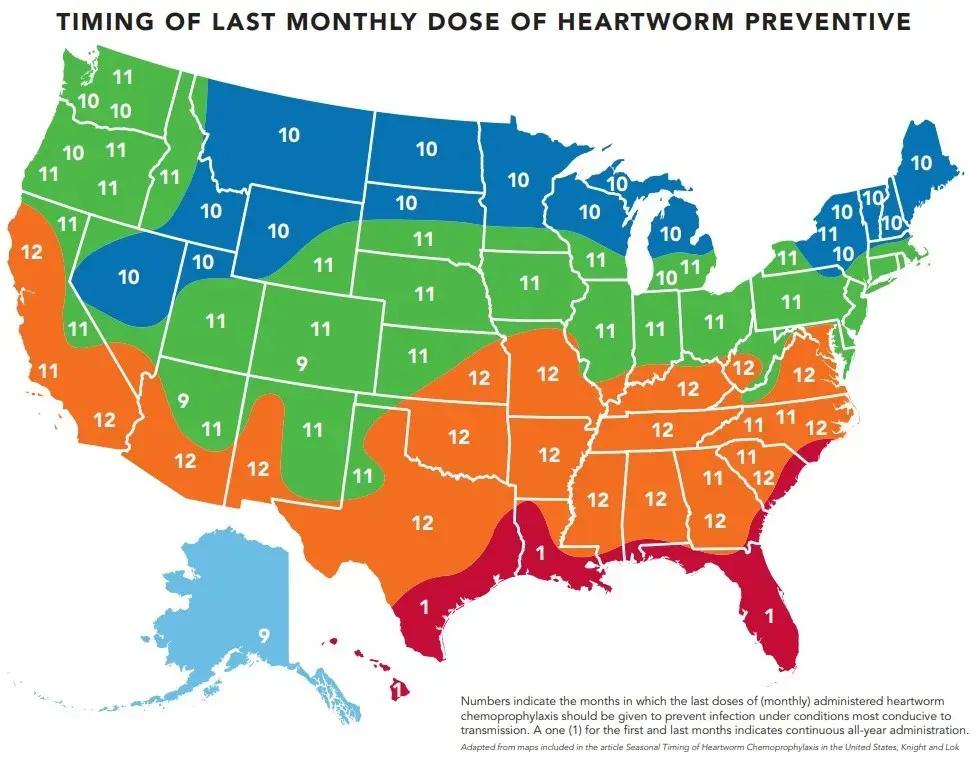The Worst Mistakes You Can Make Regarding Heartworm
I simply don't agree with some of the recommendations out there regarding heartworm prevention for dogs and cats. If you follow the advice from heartworm medication manufacturers - and some vets - you risk poisoning your pet with health-harming chemicals that don't actually prevent anything.

STORY AT-A-GLANCE
- The American Heartworm Society, heartworm drug manufacturers, and many conventional veterinarians encourage giving year-round preventives (chemical insecticides with side effects) to every dog and cat, everywhere
- My alternative recommendation is to assess your pet's actual risk of acquiring heartworms based primarily on where you live, which dictates the mosquito population
- If you live in an area where mosquitoes are a problem, I recommend working with an integrative veterinarian to develop a sensible preventive protocol to keep your pet safe and healthy
- It's also important in mosquito-endemic areas to have your pet tested for heartworms and other parasitic diseases at the beginning and again at the end of pest season
The American Heartworm Society, heartworm drug manufacturers, and many conventional veterinarians recommend giving heartworm preventives 12 months a year, no matter where you live or your pet's individual risk of exposure.
This isn't a wise or logical approach, in my opinion, since where you live is the most important consideration in assessing your pet's risk. I absolutely do not agree that every pet, everywhere, should be given a chemical insecticide once a month, year in and year out.
No drug is entirely harmless. Heartworm preventives are chemical insecticides with the potential for short- and long-term side effects that can damage your pet's health. In addition, many pet parents don't realize these preventives don't actually prevent anything. They poison heartworm larvae at the microfilaria stage of development, causing them to die inside the body.
And in addition to concerns about the toxicity of these insecticides, there's also evidence that heartworms are becoming resistant to them.
Overexposure to Heartworm Preventives
According to the 2023 heartworm prevalence map published by the Companion Animal Parasite Council (CAPC), just 1 out of every 100 dogs in the U.S. has tested positive for heartworm. And despite the fact that cats aren't natural hosts for heartworm, year-round preventives are recommended for them as well.
In addition, in only 9 states are dogs considered at high risk for heartworm infection. These numbers have remained essentially unchanged since the first map was created in 2012. The 9 states are primarily in the southeast, where soaring temperatures and high humidity during the warmer months of the year provide an ideal environment for mosquitoes to thrive.
You can use the heartworm prevalence map linked above to drill down to not only your state, but also your county to get information about the prevalence of heartworm disease (as well as other parasitic diseases) in your area.
The problem with conventional veterinary recommendations on heartworm prevention is that instead of focusing on the likelihood of infection and the risks vs. benefits of administering a toxic chemical every month of every year of an animal's life, the focus is on the scary nature of a disease that occurs in only a small percentage of dogs.
It's important to understand that heartworm preventives are, as I mentioned above, chemical insecticides. In addition to concerns about their toxicity, there is also evidence of growing heartworm resistance to preventives — resistance that is typically the result of overuse of certain classes of drugs.
Perhaps the traditional veterinary community is well-intentioned in their year-round heartworm prevention recommendations, but along with the drawbacks I've already discussed, their approach also assumes pet parents can't be trusted to figure out when it's appropriate to protect dogs from mosquito bites.
Best Time to Start and Stop Preventives
There are only a few areas in the U.S. in which giving a year-round heartworm preventive might be advisable — meaning the risk of infection may outweigh the risks associated with 24/7/365 exposure to a chemical insecticide. Those areas are in south Texas, south Florida, and a few other locations along the Gulf Coast.
The rest of the U.S. ranges from 3 to 7 months of high exposure risk. The majority of states are at 6 months or less. If you're concerned your dog is at risk of a heartworm infection, in consultation with your integrative veterinarian, you can use the following maps to guide you in when to start and stop a heartworm preventive.


For example, if you live on the Gulf Coast in either Texas or Florida where mosquitoes are a problem, the map suggests you begin giving a preventive on day 1 of month 1 (January), and give it year-round. However, if you live in western Oregon or Washington, the map suggests you start dosing in July-August and stop in October-November.
It's important to keep in mind that these maps are only one tool in your toolbox. Let's say you live in southern Nevada where mosquitoes are almost unheard of, yet the map suggests giving a preventive starting in May and continuing through the end of the year. If that doesn't make sense to you, use your common sense.
Factor in your own knowledge and experience of the area in which you live when assessing your pet's risk.
Important Heartworm Prevention Tips
If you live in an area of the U.S. where mosquitoes are common and you know your dog's risk of exposure to heartworm disease is significant, here are my recommendations for protecting your furry family member:
- If you don't live in a tick-endemic area (for example, if you live in North Dakota), with guidance from an integrative veterinarian, try using natural preventives like heartworm nosodes rather than chemicals. Make sure to do heartworm testing every 3 to 4 months (not annually), as natural heartworm preventives can't guarantee your pet will never acquire the disease.
It's important to note that since heartworms live in the bloodstream, natural GI (gastrointestinal) dewormers such as diatomaceous earth, and anti-parasitic herbs (e.g., wormwood, pumpkin seed, black walnut tinctures) are not effective at killing larvae in the bloodstream. - Focus on keeping your pet's immune function robust by feeding a species-specific, nutritionally balanced, fresh food diet that helps bolster natural defenses. Unprocessed meats are rich in B vitamins (and a less allergenic option than offering brewer's yeast). Also, specific anti-parasitic foods such as fresh garlic can be added in small quantities to provide additional support.
- If your dog's kidneys and liver are healthy, try using a chemical preventive at the lowest effective dosage. This could mean having the ivermectin compounded, if necessary, for dogs weighing in at the low end of dosing instructions. Give the treatment at 6-week intervals rather than every 4 weeks, for the minimum number of months required during mosquito season.
- Avoid all-in-one chemical products that claim to get rid of multiple types of GI parasites and external parasites as well. The goal is to use the least amount of chemical necessary that successfully treats heartworm. Adding other chemicals to the mix increases the toxic load your dog's body must contend with. Also avoid giving your pet a chemical flea/tick preventive during the same week.
- Follow up all heartworm medications with natural liver detox agents like milk thistle and SAMe for a week after treatment, in consultation with your veterinarian.
- Always insist on a heartworm test before beginning any preventive treatment. If you live or spend time with your pet in areas where mosquitoes and other pests, especially ticks, are prevalent, ask your veterinarian for a SNAP-4Dx test or an Accuplex test, both of which check for Lyme disease, ehrlichiosis, and anaplasmosis, along with heartworm.
I like to run the SNAP-4Dx every 6 months on dogs who spend a lot of time outdoors during warmer weather because parasites are becoming resistant to heartworm and flea/tick chemicals. The sooner we identify an infection in your pet, the sooner a protocol can be instituted to safely treat it with fewer long-term side effects.
If you live in the midwest or the east coast of the U.S., it's a good idea early in the year and at the end of pest season to check for these illnesses, which can be resistant to preventives and are relatively easy to treat and cure when they're identified before they create chronic disease.











